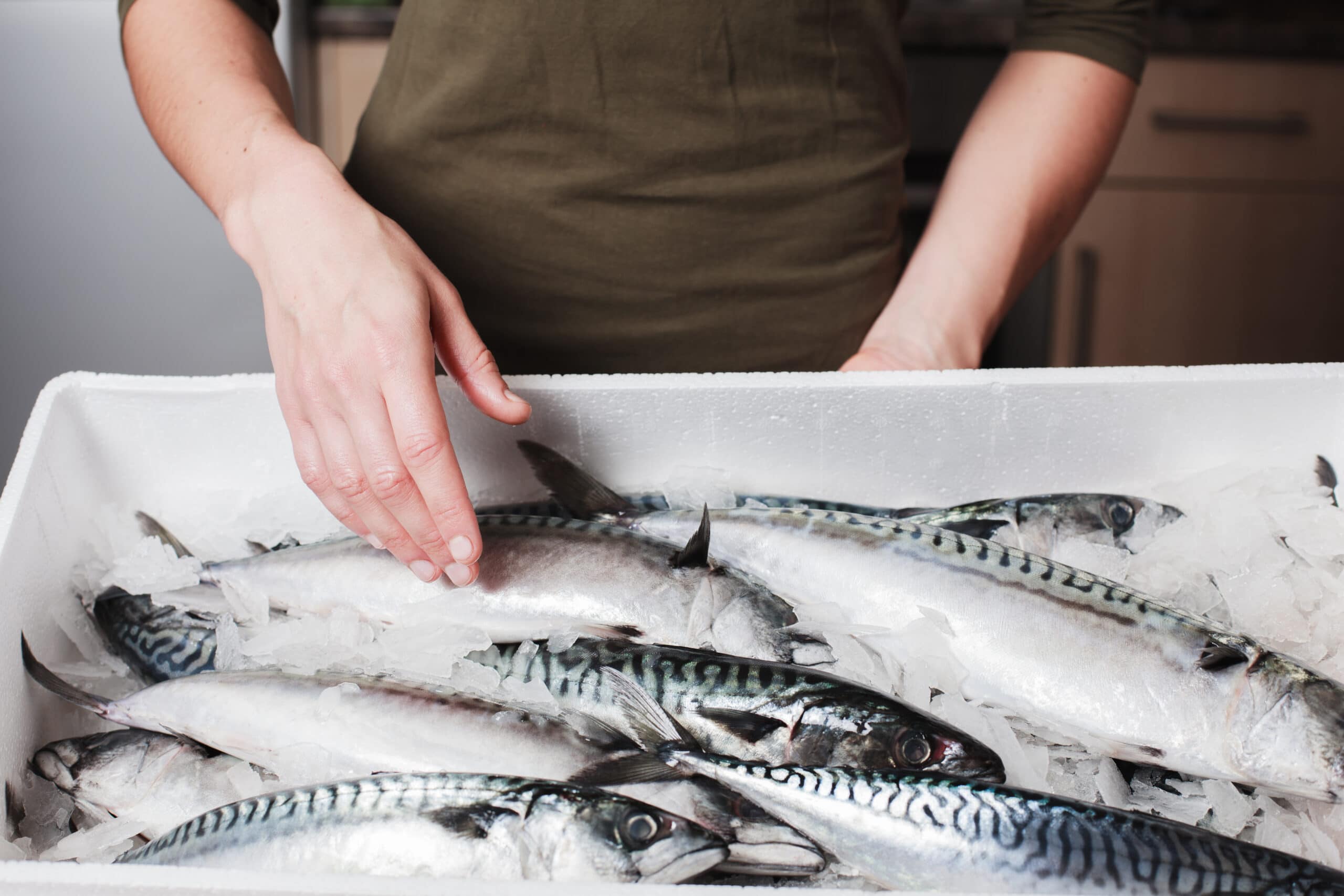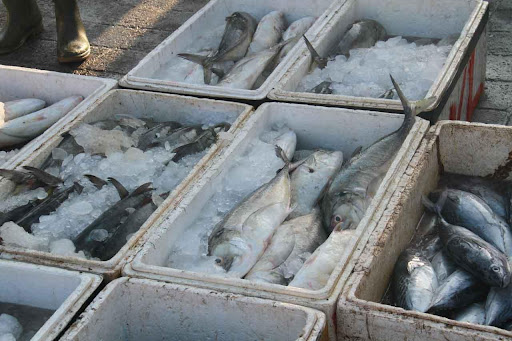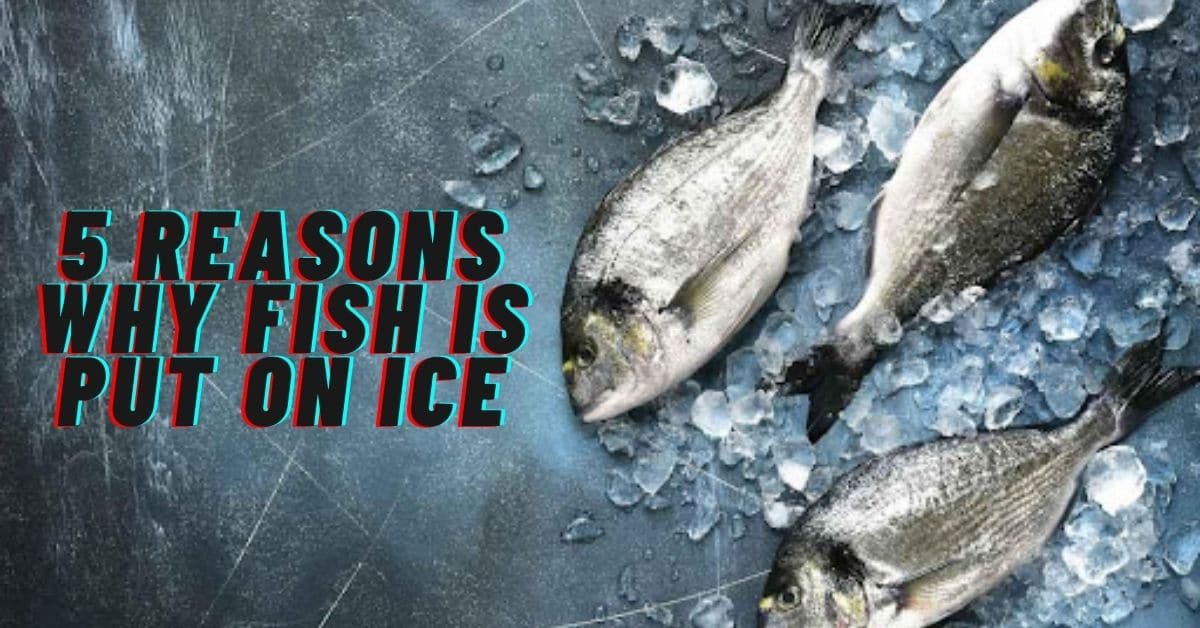For centuries, human beings have preferred eating fresh fish over other kinds of fish products. Even ancient Chinese anglers always stored fish in natural ice over three centuries ago. And this has left many fish lovers wondering why fish is put on ice, so after thorough research, we compiled the following article on 5 reasons why fish is put on ice?
Ice has been used to cool fresh fish and other fish products in the fishing industry for centuries. Ice prevents the development of bacteria and premature spoilage of fresh fish.
All freshly caught fish must be washed and gutted after being reeled in, but if that is not possible, you should store it in a cooler with ice. The cooler must have a false bottom that helps drain the melted ice. So in this article, we’ll show you why fish is put on ice and how long fish last on ice before cleaning.
How Is Fish Handled Immediately After Being Caught?
Generally, how you handle the fresh fish from the time you catch it and pull it out of the water has a significant impact on the fish’s freezer storage life, taste, and quality. After all, the bacteria present in the fish’s intestines will start affecting them as soon as they die. So here are some of the things you should never do to the fish after reeling it in:
- Never allow it to flop around in your vessel, as it will leave your catch with some bruises that will affect the quality of the frozen product.
- If gutting it is not an option immediately after catching it, you should never allow them to float on the frozen water; instead, if you know why fish is put on ice, you should preserve it correctly. And that is because their bodies will absorb the water, which will affect the texture and flavor of the meat. And if your cooler doesn’t have a false bottom, you can stop and pour the melted water a couple of times while driving home.
- To prevent the spread of food-borne illness bacteria, you should never handle the fish with dirty hands when gutting them.
Once you get home, you can clean the fish with running water and scrape off the scales using a blunt knife. And to remove the guts, you can cut it from the head to the vent and remove the entrails before cutting the head.
Remove the dorsal fins by cutting along the fish’s sides and pulling it out. Finally, you can prepare to store the fish on ice.
Why Is Fish Put On Ice?

The idea of chilling fresh fish in ice isn’t a new practice; in fact, the Ancient Romans used natural ice and seaweeds to store fish. In China, anglers started storing fish on ice over three centuries ago.
And in the United States and the whole of Europe, this idea was introduced over a century ago, and the introduction of mechanical refrigerators made ice preservation easier.
Therefore, it’s no surprise that anglers still use the same preservation method to date.
After all, fish can stay fresh for a very long time when properly chilled than when not preserved in ice. All the fishing vessels that spend days in fishing operations can benefit from preserving their catch using either chilled saltwater or ice if the anglers know why fish is put on ice.
The increased demand for fresh fish has forced most fishing firms to store their catch using ice on board, with others preferring to transport live fish.
Unfortunately, producing ice while on the boat fishing takes a lot of energy; therefore, anglers have come up with many methods for preventing wastage.
Some of the best methods that can help reduce wastage include using insulated ice containers and boxes. So, here are some reasons why fish is put on ice, and some of the main ones are:
- Temperature Reduction
The main reason why fish is put on ice is to help with temperature reduction. And that is because, when frozen, the spoiling process of fish is halted temporarily. Spoilage of fish is triggered by a series of changes caused by bacteria, chemical action, and enzymes. There are millions of bacteria in its intestines and on the surface slime and gills.
Luckily, icing can prevent fish spoilage by slowing down the growth process of the bacteria in the fish’s gills and intestines.
The freezing temperature slows down the reaction time and activities of the enzymes in the fish’s tissues and gut. Remember, these enzymes continue working even after the fish has died, so stopping them is mandatory if you plan on keep the fish fresh.
Lowering the temperature to zero degrees Celsius prevents the activities of the enzymes responsible for post mortem changes and the growth of pathogenic microorganisms that can end up spoiling the meat.
Therefore, the faster the temperature is reduced, the better.
- The Melting Ice Keeps The Fish Moist
Even when placed in coolers, ice melts, so anyone who knows why fish is put on ice may be wondering if the water has any effect on their catch?
Well, storing fish in melted water has positive and negative effects. But in most cases, the positive effects outweigh the negative effects.
The water can reduce weight loss and surface dehydration. Water conducts heat or cold faster than air; therefore, the melted water can help faster exchange heat between the ice and fish.
And if ice is not used immediately after reeling the catch into the boat for some reason, you can put the fish moist using the melted ice.
More Reasons Why Fish Are Put on Ice
Another reason why fish is put on ice is the evaporative cooling can help lower the temperature of the fish to the optimum bacteria growth temperature.
Even though evaporative cooling doesn’t prevent spoilage, it reduces the growth of pathogenic bacteria, which slows down the spoilage rate and gives you more time to prepare more ice.
Unfortunately, the melted water has some leaching effects and can quickly dilute the color pigments on the fish’s gills and skin. The water can also remove a huge percentage of the soluble parts in some species like squids or remove the macronutrients in fillets. Therefore, the amount of melted water allowed to be used to preserve the fish will depend on the species.
But in general, the melted ice has more benefits on coolers containing refrigerated seawater or chilled seawater. But the effects of the melted seawater must be well assessed in order to avoid some effects like whitening of the gills and eyes, plus uptake of salt from the water.
- Beneficial Physical Properties
Ice has lots of beneficial physical properties that will never make you question why fish is put on ice. Compared to other preservation methods like refrigeration by air, ice has lots of advantages. Some of the main properties that make ice the best option include:
The Melting Process Is A Cooling System On Its Own
Generally, ice melting refers to the change in form from solid to a liquid state, and in most cases, it can occur at a similar temperature. This beneficial property makes it possible for anglers to deliver fresh fish to the market every time.
The melting ice around the fish uses its self-contained temperature controlling system to keep the fish cool at zero degrees Celsius at all points on the cooler.
But with controlled refrigeration systems, melting occurs at varying temperatures on different parts of the fish.
Therefore, the only cooling system that can guarantee an even temperature when melting is the ice, which is the main reason fish is put on ice.
Ice Has A Vast Cooling Capacity
Ice has a latent heat of fusion of approximately 80kcal/kg; therefore, you need a tiny amount of ice to keep 1 kg of fish cool. For example, you will need 0.25kg of ice to lower the temperature of 1kg of lean fish from 25 degrees Celsius to zero. And that is because the melting process of ice compensates for the thermal loss.
This is the main reason why fish is put on ice in insulated containers in tropic climates. The idea of handling fish with a small amount of ice improves the economics and efficiency of handling fresh fish.
- Convenience
There are lots of practical advantages of ice that will make you understand why fish is put on ice immediately after being caught. This includes:
- Ice is a portable cooling method: ice can be easily used, transported, and even stored without melting. And depending on the kind of ice you’re using, you can easily distribute the ice uniformly around your catch.
- The raw material needed to make ice is readily available: even though pure, clean water is becoming hard to find, we can agree that it is still the most common raw material on the planet. After all, less pure water can be made clean and pure through the process of chlorination. And if you have a short supply of freshwater, you can opt for seawater.
- Ice is the cheapest means of storing fish: if ice can be properly made without wasting too much energy and properly stored and used, then it can be the most affordable preservation tool.
- It is safe for preserving food: if made using pure, clean drinking water, it can be the safest means of preserving food. It won’t pose any danger to the people handling it or the consumers.
- Extended Shelf Life
The last reason why fish is put on ice is icing your catch is extending their shelf life. Icing is the simplest and reliable method possible as compared to refrigeration at 0°C. But increasing the shelf life means delivering safe, fresh fish with the highest acceptable qualities to the consumers.
Remember, fish is highly perishable goods; therefore, it’s crucial that we ensure that the buyer and consumers receive fresh fish even when not processed.
Therefore, refrigeration and icing, in general, helps extend the shelf life of the fresh fish, thus converting it into a commodity that has been considered an article of trade for centuries.
What Type Of Ice Can I Use To Keep My Fish Safe?
Generally, ice can be produced in a wide range of shapes depending on the type of ice machine used. But the most common ice used for storing fish is a block, tube, plate, and flake. But block ice must be ground before being used. Unfortunately, ground ice can form sharp crystals that can damage the fish’s scales.

How Long Will Fish Last On Ice Before Cleaning?
If you’re wondering why fish is put on ice, then you may also be wondering how long it can remain fresh when iced. Storing fresh fish in ice can help slow down their spoilage process, but it can’t halt it.
Therefore, it is a power race against time, and as the angler, you should do your best to deliver the fish to the market as fast as possible. So the main question in many anglers’ minds is how long will fish last on ice before cleaning? Well, the answer will depend on numerous factors.
And based on some studies, tropical fishes can stay longer when stored on ice than the ones caught in cold and temperate waters. This is attributed to the fact that the bacterial growth rate of tropical fishes has a 1-2 weeks slower rate.
So before finding out how long fish can last on ice before being cleaned, we need to know the main factors that can affect their shelf life. And this includes:
- Temperature: it’s a known fact that high temperatures accelerate the spoilage rate while freezing temperatures help preserve them. But the rate at which the temperature of the fish drops also plays a crucial role in the quality of the meat and how fast the spoilage activity is stopped.
- Physical damages: Another factor that can affect the shelf life of fresh fish after being caught is physical damages. Fishes have very soft skins that can be damaged by rough handling. The bruise can result in contamination of the fish’s flesh after the enzymes and bacteria are introduced. This can increase the rate of spoilage.
- Intrinsic factors: knowing the intrinsic factors that can affect the fish’s shelf lif can help you understand why fish input on ice. The size, shape, skin properties, and fat content can affect the shelf life of your fish. Some of the intrinsic factors that can affect the shelf life of most fishes include:
Table: Intrinsic factors affecting the spoilage rate or fish
| Intrinsic factors | Relative spoilage rate of chilled fish | Relative spoilage rate of chilled fish |
| Slow rate | Fast rate | |
| Shape | Flatfish | Round fish |
| Size | Large fish | Small fish |
| Skin characteristics | Thick skin | Thin skin |
| Fat content in the flesh | Lean species | Fatty species |
But it’s always a good idea to clean the fish and remove the dirt and slime on its scales before gutting it as soon as possible. But if that is not possible, most anglers recommend storing it properly in a cooler filled with ice for between 24 to 36 hours.
The amount of time the fish can remain on ice and not spoilt before being cleaned will depend on how it’s preserved.
If well preserved, the fish can remain fresh for an even longer time, but if you don’t keep the temperature low, you may have issues keeping it fresh for a long time.
How Long Can Processed Fish Remain Fresh?
Generally, the shelf life of fish on ice before processing ranges between 2 to 24 days for temperate water species and 6 to 40 days for tropical water species.
Table: The shelf life of processed iced fish
| Species | Shelf-life in number of days |
| Snapper | 10-28 |
| catfish | 16-19 |
| Spadefish | 21-26 |
| Flounder | 7-18 |
| Mackerel | 4-19 (Temperate waters), 14-18 (tropical waters) |
| Flounder | 7-18 |
| Sardine | 3-8 (temperate waters), 9-16 (tropical waters) |
| Tilapia | 10-27 |
| Carp | 16-21 |
| Trout | 9-11 (temperate waters), 16-24 (tropical waters) |
| Perch | 8-17 (temperate waters), 13-32 (tropical waters) |
FAQs
Do You Have To Put Fish On Ice After Reeling It In?
After the catch, you need to wipe their surface with a paper towel and keep them moist but not wet. Wrap the clean fish with plastic wrap and place them in sealable bags. Finally, you can insert them in the sealable bags on ice and if you have to put them directly on ice, make sure you remove the melted water a couple of times.
How Long With Freshly Caught Fish Remain Fresh In The Refrigerator?
Generally, you can store the fish in the refrigerator without gutting it for only two days. Lean species like walleye store better than trout. Huge fishes can stay longer than smaller ones.
How Long After Reeling It In Should I Take Before Cleaning The Fish?
The best time to clean it is as soon as it dies, but if that’s not possible, you can clean it within the first two hours of catching it. You will require to put the fish on ice until you’re ready to clean and then gut it.
Conclusion
The fish’s quality, flavor, and taste when it finally reaches the consumer will be determined by how well you ice it.
Therefore, you should have a reliable onboard icing compartment ready for the catch since you already know why fish is put on ice. After all, you may not have time to clean it, leave alone gut it.


Cory Haasnoot
Cory is a content writer-editor and founder of Tackle Box Talk. Favorite Quote: "Give a man a fish, and you feed him for a day. Teach a man to fish, and you feed him for a lifetime."